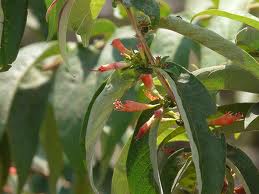| PlantID | 0136 |
| Botanical Name | Woodfordia fruticosa |
| Common Name | Dhai |
| Classification | | Kingdom: | Plantae | | Subkingdom: | Tracheobionta | | Division: | Magnoliophyta | | Class: | Magnoliopsida | | Subclass: | Rosidae | | Order: | Myrtales | | Family: | Lythraceae | | Genus: | Woodfordia | | Species: | fruticosa |
|
| Part used | Flowers |
| Medicinal Properties | Flowers: astringent, stimulant, intoxicating and antidotal. |
| Medicinal Use | The flowers are very useful in dysentery, diarrhoea, fever, hemorrhoids, herpes, leprosy, burning sensation, skin diseases, internal hemorrhage, impaired hepatic function, leukorrhea, menorrhagia and considered as a safe stimulant pregnancy. The juice of its fresh flowers applied on the forehead, reduces the headache. Dried flower powder is used in ulcers and wounds to reduce the discharge and promote granulation.
|
| Chemistry | Beta-Sitosterol from various parts; Seeds: linoleic, oleic, palmitic and stearic acids; Flowers: octacosanol(also from stem), chrysophanol-8-O-Beta-D-glucopyranoside, cyanidin-3,5-diglucoside, glucose, tannins, hecogenin, inositol, woodfordins A,B and C; Flowers-Leaves: ellagic acid, myricetin-3-galactoside, pelargonidin-3,5-diglucoside, polystachoside; Leaves: lawsone, betulin, betulinic acid, lupeol, oleanolic and ursolic acids.
|
| Cultivation | NA |
| Regional Habitat | Throughout Rajasthan, found at open, waste land and degraded places. |
| Description | A bushy shrub, with long, spreading branches, pubescent, young branchlets and leaves with numerous, small, black glands. Leaves: opposite or subopposite, grey-pubescent beneath, ovate- or linear-lanceolate. Flowers: scarlet, showy, tubular on slender pedicels dilated above, borne in axillary clusters. Capsules: ellipsoid, membranous, included in the calyx. Seeds: cuneate-obovate, smooth. Flowers in February-April and fruits in April-June.
|
| Image |  |


